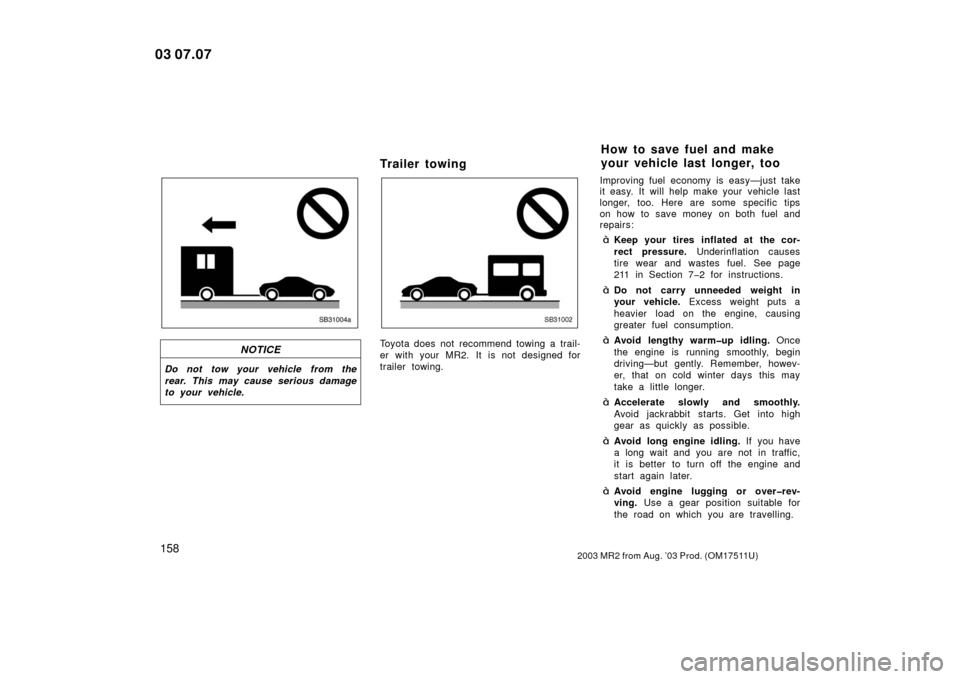Page 7 of 265

vi2003 MR2 from Aug. ’03 Prod. (OM17511U)
Tires and loading on your Toyota
Underinflated or overinflated tire inflation pres-
sure and the excess load may result in the
deterioration of steering ability and braking abil-
ity, leading to an accident. Check the tire infla-
tion pressure periodically and be sure to keep
the load limits given in this Owner ’s Manual.
For details about tire inflation pressure and
load limits, see pages 211 and 149.
Scrapping of your Toyota
The SRS airbag and seat belt pretensioner devices in
your Toyota contain explosive chemicals. If the vehicle
is scrapped with the airbags and pretensioners left as
they are, this may cause an accident such as fire. Be
sure to have the systems of the SRS airbag and seat
belt pretensioner removed and disposed of by a qualified
service shop or by your Toyota dealer before you dis-
pose of your vehicle.
Sequential manual
transmission driving tips
(Models equipped with Sequential Manual
Transmission only)
The sequential manual transmission is a 6�speed forward/
reverse transmission. With the basics of the traditional
manual transmission, the clutch operation and transmission
shifting is controlled electronically. Unlike automatic trans-
missions, this system does not upshift automatically at the
time of acceleration.
To understand the unique system and operation method of
the sequential manual transmission, read Section 1�6 on
page 85 thoroughly before driving. For starting procedures,
see “How to start the engine— ” on page 154 in Section 3.
Please refer to the “Important Information For Your
Sequential Manual Transmission” equipped in your vehicle
as well.
03 07.07
Page 150 of 265
1412003 MR2 from Aug. ’03 Prod. (OM17511U)
This illustration indicates typical tire
symbols.1. Tire size— For details, see “Tire
size” on page 143.
2. DOT and Tire Identification Number (TIN)— For details, see
“DOT and Tire Identification Num-
ber (TIN)” on page 142.
3. Maximum cold tire inflation pressure— This means the pres-
sure to which a tire may be in-
flated. For recommended cold tire
inflation pressure, see “Tires” on
page 242.
4. Load limit at maximum cold tire inflation pressure— For details,
see “Checking and replacing tires”
on page 213.
5. Location of tread wear indica- tors— For details, see “Checking
and replacing tires” on page 213.
6. Turning indicator— Some
vehicles are equipped with
directional tires. For details, see
“Rotating tires” on page 216.
03 07.07
Tire information—
—Tire symbols
SB21020b
Page 154 of 265
1452003 MR2 from Aug. ’03 Prod. (OM17511U)
Warning: The temperature grades for
this tire are established for a tire that
is properly inflated and not over-
loaded. Excessive speed, underinfla-
tion, or excessive loading, either sep-
arately or in combination, can cause
heat buildup and possible tire failure.
03 07.07
Page 155 of 265

1462003 MR2 from Aug. ’03 Prod. (OM17511U)
Cold tire inflation pressureTire inflation pressure when the vehicle has been parked at least 3 hours or
more, or it has not been driven more than 1.5 km or 1 mile under that condition
Maximum inflation pressureThe maximum cold inflation pressure to which a tire may be inflated and shown
on the sidewall of the tire
Recommended inflation pressureCold tire inflation pressure recommended by a manufacturer
Accessory weight
The combined weight (in excess of those standard items which may be re-
placed) of automatic transmission, power steering, power brakes, power win-
dows, power seats, radio, and heater, to the extent that these items are avail-
able as factory�installed equipment (whether installed or not)
Curb weight
The weight of a motor vehicle with standard equipment including the maximum
capacity of fuel, oil, and coolant, and, if so equipped, air conditioning and addi-
tional weight optional engine
Maximum loaded vehicle weight
T he sum of —
(a) Curb weight;
(b) Accessory weight;
(c) Vehicle capacity weight; and
(d) Production options weight
Normal occupant weight68 kg (150 lb.) times the number of occupants specified in the second column
of Table 1 that follows
Production options weight
The combined weight of those insta lled regular production options weighing
over 2.3 kg (5 lb.) in excess of those standard items which they replace, not
previously considered in curb weight or accessory weight, including heavy duty
brakes, ride levelers, roof rack, heavy duty battery, and special trim
03 07.07
—Tire relat ed terms
Page 156 of 265

1472003 MR2 from Aug. ’03 Prod. (OM17511U)
Vehicle capacity weight
(Total load capacity)The rated cargo and luggage load plus 68 kg (150 lb.) times the vehicle’s
designated seating capacity
Intended outboard sidewall
(A) The sidewall that contains a whitewall, bears white lettering or bears
manufacturer, brand, and/or model name molding that is higher or deeper
than the same molding on the other sidewall of the tire, or
(B) The outward facing sidewall of an asymmetrical tire that has a particula
r
side that must always face outward when mounted on a vehicle
Occupant distributionDistribution of occupants in a vehicle as specified in the third column of Table
1 that follows
RimA metal support for a tire or a tire and tube assembly upon which the tire beads
are seated
Rim diameter (Wheel diameter)Nominal diameter of the bead seat
Rim size designationRim diameter and width
Rim type designationThe industry of manufacturer ’s designation for a rim by style or code
Rim widt hNominal distance between rim flanges
Vehicle maximum load on the tireThe load on an individual tire that is determined by distributing to each axle
its share of the maximum loaded vehicle weight and dividing by two
Vehicle normal load on the tire
The load on an individual tire that is determined by distributing to each axle
its share of the curb weight, accessory weight, and normal occupant weight
(distributed in accordance with Table 1 that follows) and dividing by two
Weather sideThe surface area of the rim no t covered by the inflated tire
03 07.07
Page 167 of 265

1582003 MR2 from Aug. ’03 Prod. (OM17511U)
SB31004a
NOTICE
Do not tow your vehicle from the
rear. This may cause serious damage
to your vehicle.
Trailer towing
SB31002
Toyota does not recommend towing a trail-
er with your MR2. It is not designed for
trailer towing.Improving fuel economy is easy—just take
it easy. It will help make your vehicle last
longer, too. Here are some specific tips
on how to save money on both fuel and
repairs:
�Keep your tires inflated at the cor-
rect pressure.
Underinflation causes
tire wear and wastes fuel. See page
211 in Section 7�2 for instructions.
�Do not carry unneeded weight in
your vehicle. Excess weight puts a
heavier load on the engine, causing
greater fuel consumption.
�Avoid lengthy warm�up idling. Once
the engine is running smoothly, begin
driving—but gently. Remember, howev-
er, that on cold winter days this may
take a little longer.
�Accelerate slowly and smoothly.
Avoid jackrabbit starts. Get into high
gear as quickly as possible.
�Avoid long engine idling. If you have
a long wait and you are not in traffic,
it is better to turn off the engine and
start again later.
�Avoid engine lugging or over�rev-
ving. Use a gear position suitable for
the road on which you are travelling.
03 07.07
How to save fuel and make
your vehicle last longer, too
Page 170 of 265

1612003 MR2 from Aug. ’03 Prod. (OM17511U)
IN CASE OF AN EMERGENCY
In case of an emergency
If your vehicle will not start162
. . . . . . . . . . . . . . . . . . . . . . . . . . . . . . . . . . .
If your engine stalls while driving 165
. . . . . . . . . . . . . . . . . . . . . . . . . . . . .
If you cannot increase the engine speed 166
. . . . . . . . . . . . . . . . . . . . . .
If your vehicle overheats 166
. . . . . . . . . . . . . . . . . . . . . . . . . . . . . . . . . . . . \
If you have a flat tire 167
. . . . . . . . . . . . . . . . . . . . . . . . . . . . . . . . . . . . \
. . . . .
If your vehicle becomes stuck 176
. . . . . . . . . . . . . . . . . . . . . . . . . . . . . . . .
If your vehicle needs to be towed 177
. . . . . . . . . . . . . . . . . . . . . . . . . . . . .
If you cannot shift the sequential manual transmission selector lever 181
. . . . . . . . . . . . . . . . . . . . . . . . . . . . . . . . . . . . \
. . . . . . . . . .
If you lose your keys 182
. . . . . . . . . . . . . . . . . . . . . . . . . . . . . . . . . . . . \
. . . .
03 07.07
SECTION 4
Page 176 of 265

1672003 MR2 from Aug. ’03 Prod. (OM17511U)
6. After the engine coolant temperaturehas cooled to normal, again check the
coolant level in the reservoir. If neces-
sary, bring it up to half full again. Seri-
ous coolant loss indicates a leak in the
system. You s hould have it checked as
soon as possible at your Toyota dealer.
If you have a flat tire—
1. Reduce your speed gradually, keeping a straight line. Move cau-
tiously off the road to a safe place
well away from the traffic. Avoid
stopping on the center divider of
a highway. Park on a level spot
with firm ground.
2. Stop the engine and turn on your emergency flashers.
3. Firmly engage the parking brake and put the transmission lever in
“R” (sequential manual transmis-
sion) or in reverse (manual trans-
mission).
4. Have everyone get out of the ve- hicle on the side away from traffic.
5. Read the following instructions thoroughly.CAUTION
When jacking, be sure to observe
the following to reduce the possi-
bility of personal injury:
�Follow jacking instructions.
� Do not put any part of your
body under the vehicle sup-
ported by the jack. Personal in-
j u ry may occu r.
� Do not start or run the engine
while your vehicle is supported
by the jack.
� Stop the vehicle on a level firm
ground, firmly set the parking
brake and put the transmission
in “R” (sequential manual
transmission) or in reverse
(manual transmission). Block
the wheel diagonally opposite
to the one being changed if
necessary.
03 07.07